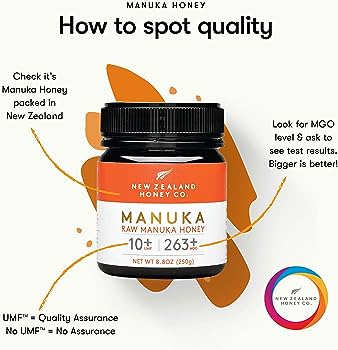
If you’re interested in trying manuka honey and reaping its potential health benefits, it’s important to know what to look for when purchasing a jar. With its unique properties and growing popularity, choosing the right manuka honey can be a bit overwhelming. In this article, we’ll provide you with a handy guide on what to look for in manuka honey, ensuring that you find the authentic and high-quality product that’s right for you.
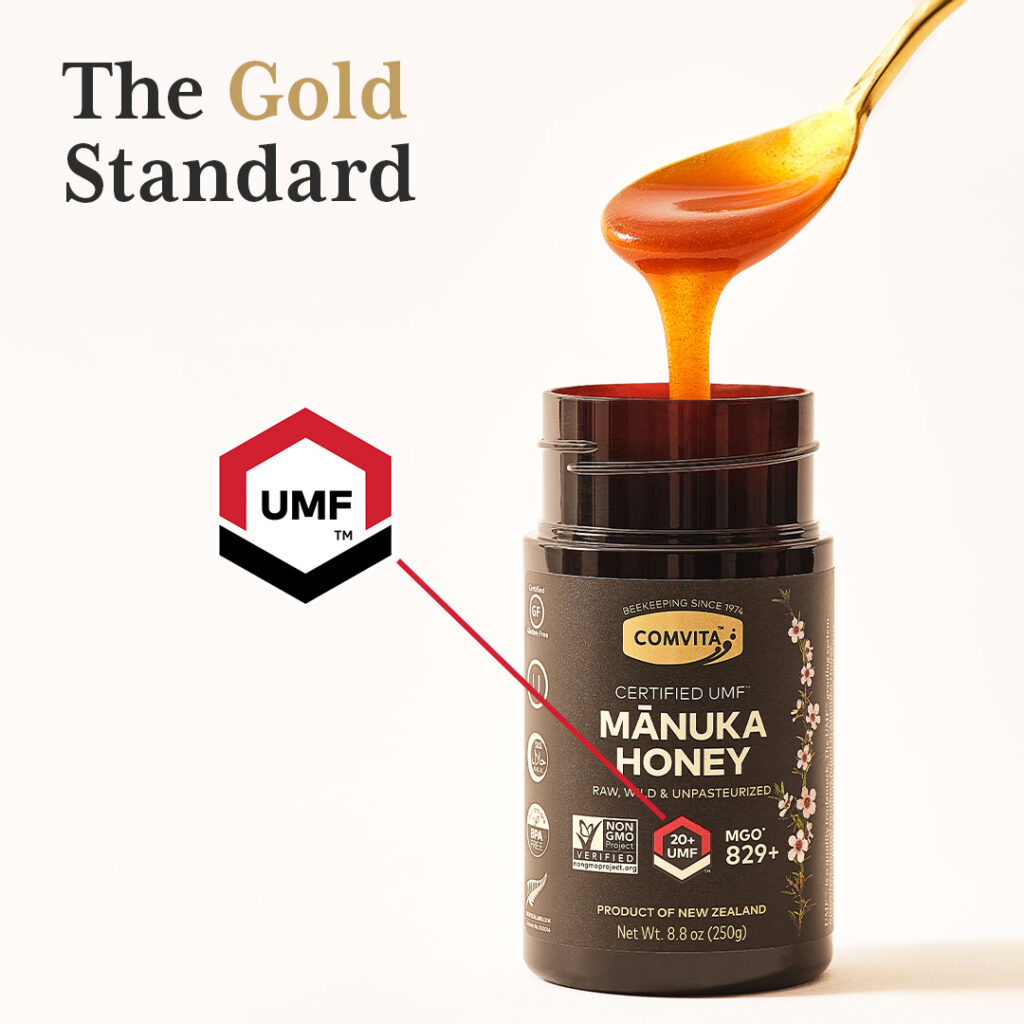
Quality Indicators
Unique Manuka Factor (UMF)
When choosing manuka honey, one of the most important quality indicators to consider is the Unique Manuka Factor (UMF). The UMF is a grading system that measures the potency and purity of the honey. It takes into account various markers such as the presence of certain chemical compounds and antibacterial activity. A higher UMF rating indicates a higher level of these beneficial properties, making the honey more potent and effective.
Methylglyoxal (MGO) Content
Another crucial quality indicator for manuka honey is the Methylglyoxal (MGO) content. MGO is a naturally occurring compound that is responsible for the antibacterial activity in manuka honey. The higher the MGO content, the stronger the honey’s antimicrobial properties. So, when selecting manuka honey, consider the MGO level to ensure you get the desired therapeutic benefits.
Pollen Count
Checking the pollen count of manuka honey is essential as it helps in determining the authenticity and origin of the honey. Manuka honey should have a high pollen count, indicating that it predominantly comes from the nectar of the manuka flower. A higher pollen count ensures that the honey is pure, unadulterated, and retains all the unique characteristics associated with manuka honey.
Certification Standards
Look for manuka honey that adheres to recognized certification standards. The most reputable certification in the industry is the Unique Manuka Factor Honey Association (UMFHA) certification. This certification guarantees that the honey meets specific quality standards and has undergone rigorous testing. By choosing UMFHA-certified manuka honey, you can have confidence in its authenticity and quality.
Packaging and Labeling
Pay attention to the packaging and labeling of manuka honey when making your selection. High-quality manuka honey is typically packaged in dark and opaque containers. This helps to protect the honey from light exposure, which can degrade its beneficial properties. Additionally, look for proper sealing and tamper-proofing to ensure the honey remains fresh and uncontaminated. Clear and accurate labeling, including UMF and MGO ratings, can also provide valuable information about the honey’s quality.
Authenticity Verification
UMF Licensed Trademark
To ensure the authenticity of manuka honey, look for the UMF licensed trademark on the product packaging. This trademark signifies that the honey has been independently tested and certified by the UMF Honey Association. It guarantees that the honey meets the stringent quality standards and contains the unique compounds that make manuka honey so special.
MGO Testing
Another way to verify the authenticity of manuka honey is through MGO testing. MGO is the compound responsible for the honey’s antibacterial properties. reputable brands often conduct MGO testing to determine the honey’s MGO content accurately. This testing provides an additional layer of assurance that you are purchasing genuine manuka honey of the desired potency.
Traceability and Batch Codes
Trusted manuka honey brands often provide traceability and batch codes on their packaging. These codes allow consumers to trace the honey’s journey from hive to shelf. By scanning or entering the batch code on the manufacturer’s website, you can access detailed information about the honey, including its source, quality testing results, and authenticity verification. Having access to this information builds trust and confidence in the product you are purchasing.
Source and Origin
New Zealand Sourced
Manuka honey is native to New Zealand, and sourcing it from this country ensures its authenticity and adherence to stringent quality standards. New Zealand has the ideal climate and pristine environment for the manuka tree (Leptospermum scoparium) to thrive and produce the highest quality honey. Therefore, it is important to choose manuka honey that is sourced exclusively from New Zealand to guarantee its purity and potency.
Mānuka Flower Origin
The origin of the manuka flowers used to produce the honey also plays a significant role in its quality. Bees gather nectar from various manuka flowers, but honey derived from flowers in certain regions of New Zealand is believed to be more potent. For example, manuka honey sourced from the East Cape region is highly sought after due to the unique characteristics of the manuka flowers found there. Considering the manuka flower origin adds another layer of distinction to your manuka honey selection.
Beekeeping Practices
The beekeeping practices employed in the production of manuka honey can also impact its quality. Look for honey produced using sustainable and ethical beekeeping practices. Responsible beekeepers prioritize the welfare of their bees, ensuring they have access to a wide range of plants and flowers, including manuka. This allows the bees to produce honey that is rich in flavor and therapeutic qualities. Supporting beekeepers who practice sustainability and ethical beekeeping contributes to the overall quality of manuka honey.
Grading and Rating
UMF Grading System
The UMF grading system provides a reliable way to assess the quality and potency of manuka honey. The UMF rating, represented by a number on the packaging, indicates the honey’s level of unique compounds and antibacterial activity. A higher UMF rating signifies stronger therapeutic properties. For example, UMF 10+ is considered to have moderate activity, while UMF 20+ is highly active. Choose a UMF rating based on your desired health benefits.
MGO Rating System
The MGO rating system is another widely used method to evaluate the potency of manuka honey. The MGO rating indicates the concentration of Methylglyoxal in the honey, which directly correlates to its antibacterial strength. The higher the MGO rating, the more powerful the honey’s antimicrobial properties. Consider the MGO rating in conjunction with other quality indicators to ensure you select the right manuka honey for your needs.
Comparison and Interpretation
When comparing different manuka honey products, it can be helpful to understand how UMF and MGO ratings correlate. While the two rating systems measure different characteristics, a general guideline is that UMF 10+ is approximately equivalent to MGO 100+, UMF 15+ to MGO 250+, and UMF 20+ to MGO 400+. However, it’s important to note that this is not an exact conversion, as the rating systems consider different markers. Always refer to the specific UMF and MGO ratings provided on the packaging for accurate comparison and interpretation.
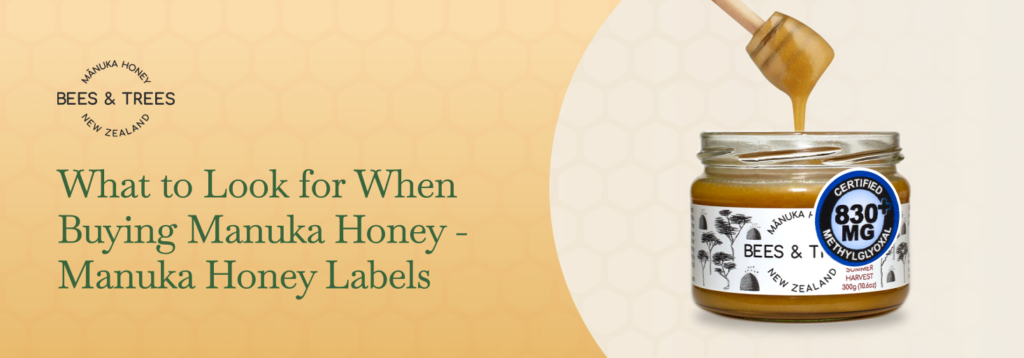
Texture and Consistency
Creaminess and Thickness
Manuka honey can vary in texture and consistency, and personal preference may play a role in your selection. Some people prefer a smooth, creamy texture that spreads easily, while others enjoy a thicker, more viscous consistency. The texture can be influenced by factors such as the floral source, harvesting techniques, and processing methods. Consider your intended use and personal preference when choosing from the different textures of manuka honey available.
Granulation and Crystallization
It’s important to note that manuka honey is prone to granulation or crystallization over time. This natural process occurs when glucose in the honey forms crystals, resulting in a grainy texture. Granulation does not affect the quality or taste of the honey but may make it less convenient to use. To restore the honey’s smooth texture, simply place the jar in warm water and gently stir until the crystals dissolve. Opting for creamed manuka honey or maintaining proper storage conditions can help minimize granulation.
Aroma and Taste
Distinctive Aroma
Manuka honey is known for its distinct aroma, often described as earthy, deep, and slightly medicinal. The aroma is a result of the unique compounds present in the honey, such as methylglyoxal. When selecting manuka honey, take a moment to inhale and appreciate its characteristic scent. The aroma can vary slightly depending on the UMF and MGO ratings, as well as the floral source and geographical region. Choose a honey with an aroma that appeals to your senses and complements your intended use.
Unique Flavor Notes
The flavor of manuka honey is equally remarkable, offering a complex and rich taste profile. It is often described as sweet yet slightly bitter, with hints of caramel and a lingering herbal undertone. The flavor can vary based on factors such as the floral source, climate, and processing techniques. Higher UMF and MGO ratings may bring out stronger and more intense flavor notes. Consider the flavor profile that aligns with your taste preferences when selecting manuka honey for culinary or therapeutic purposes.
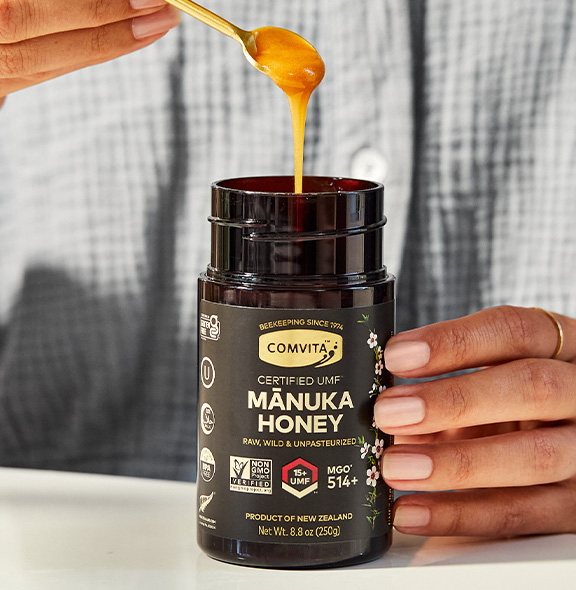
Packaging and Storage
Dark and Opaque Containers
High-quality manuka honey is typically packaged in dark and opaque containers. This type of packaging protects the honey from exposure to light, which can degrade its beneficial properties. UV rays and natural light sources can break down the honey’s enzymes and antioxidants, diminishing its overall quality. Dark and opaque containers help maintain the honey’s potency and extend its shelf life.
Proper Sealing and Tamper-Proofing
When purchasing manuka honey, ensure that the packaging has proper sealing and tamper-proofing mechanisms in place. This guarantees that the honey remains fresh and uncontaminated. Look for seals or lids that are securely attached and unbroken. Tamper-proof packaging also gives you peace of mind, knowing that the honey has not been compromised before reaching your hands.
Storage Conditions
To preserve the quality of manuka honey, it is essential to store it properly. Ideally, keep the honey in a cool, dry place away from direct sunlight and heat sources. Avoid fluctuating temperatures, as this can impact the honey’s consistency and flavor. When exposed to excessive heat, manuka honey can become runny and lose some of its natural properties. Following proper storage conditions will ensure that your manuka honey retains its integrity and remains enjoyable for an extended period.
Price and Value
Pricing Factors
The price of manuka honey can vary significantly based on various factors. These factors include the honey’s UMF or MGO rating, the region of origin, the brand’s reputation, and the overall quality of the product. Higher UMF or MGO ratings typically command a higher price due to the increased potency and therapeutic value. Additionally, honey sourced from specific regions known for high-quality manuka flowers may be priced higher. Consider your budget and the desired quality when assessing the price of manuka honey.
Assessing Value for Money
When evaluating the value for money in manuka honey, consider the quality indicators, authenticity verification, source, grading and rating, texture, aroma and taste, packaging, and storage conditions. While price is a significant factor, it is equally important to ensure that the honey meets your desired standards and offers the therapeutic benefits you seek. Assessing the overall value for money involves finding a balance between quality, authenticity, and affordability.
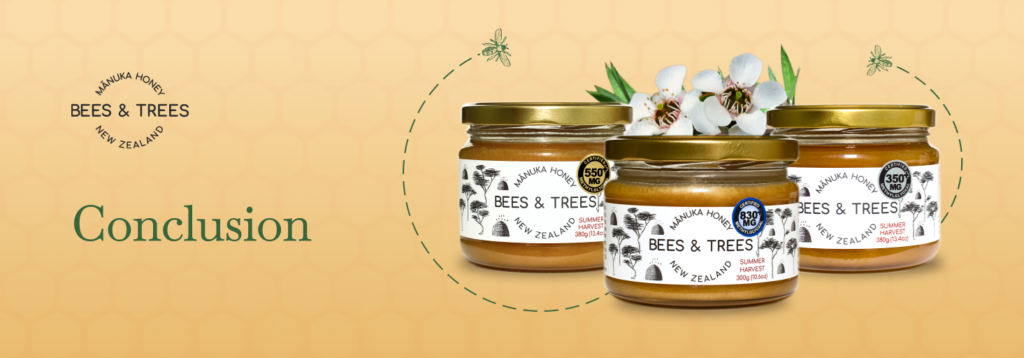
Consumer Reviews and Recommendations
Trusted Brands and Testimonials
Before purchasing manuka honey, consider consumer reviews and recommendations. Trusted brands often have a loyal customer base that can provide valuable insights into the quality and effectiveness of their products. Look for testimonials from individuals who have used the honey for various purposes, such as culinary uses or medicinal applications. Their experiences can help you make an informed decision and select a brand that consistently delivers high-quality manuka honey.
Expert Recommendations
Expert recommendations from healthcare professionals, nutritionists, and naturopaths can also be invaluable when choosing manuka honey. These experts have in-depth knowledge of the honey’s properties and can guide you towards reputable brands and products. They may provide insights into specific UMF or MGO ratings for different health conditions or suggest the most suitable manuka honey based on your requirements. Consider seeking expert advice to ensure you make the best choice for your needs.
Potential Benefits and Uses
Medicinal Properties
One of the primary reasons people seek out manuka honey is for its medicinal properties. Manuka honey has been recognized for its antimicrobial, anti-inflammatory, and antioxidant properties. It may support wound healing, soothe sore throats, and aid in digestive health. The specific therapeutic benefits can vary based on the honey’s UMF or MGO rating and the individual’s health condition. When using manuka honey for medicinal purposes, consult with a healthcare professional to determine the most appropriate potency and application.
Internal and External Applications
Manuka honey offers a range of internal and external applications. Internally, it can be consumed as a natural sweetener, added to beverages, or used in cooking and baking. Manuka honey’s unique flavor profile makes it a versatile ingredient for enhancing both sweet and savory dishes. Externally, manuka honey can be applied topically to the skin for its potential wound-healing and antibacterial properties. It can also be used in DIY face masks, hair treatments, or as a natural ingredient in skincare products. Explore the various ways you can incorporate manuka honey into your daily routine, either for culinary enjoyment or as part of your skincare regimen.
In conclusion, when looking for manuka honey, consider the quality indicators such as UMF, MGO content, pollen count, certification standards, and packaging. Verify the authenticity through the UMF licensed trademark, MGO testing, and traceability. Pay attention to the source and origin of the honey, including its New Zealand sourcing, manuka flower origin, and beekeeping practices. Understand the grading and rating systems of UMF and MGO to make informed comparisons and interpretations. Evaluate the texture and consistency, aroma and taste, packaging and storage conditions, and price in relation to the overall value provided. Consider consumer reviews and expert recommendations to guide your decision. Lastly, explore the wide range of potential benefits and uses that manuka honey offers, both internally and externally. By following these guidelines, you can confidently select the right manuka honey that meets your specific needs and preferences.
